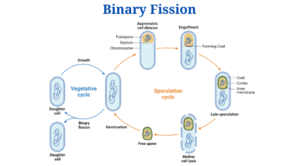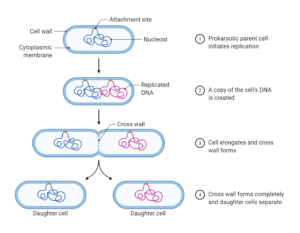Definition of Binary Fission (What is binary fission?)
- Binary fission is a method of asexual reproduction in which a single living cell or organelle doubles in size before splitting into two similar daughter cells, each of which has the potential to expand to the size of the original cell or organelle.
- Binary fission is distinguished from other types of fission in which it produces just two components from a single entity.
- Since the process does not entail the development or fusion of gametes, it is referred to as asexual reproduction.
- Since binary fission is a method of an asexual reproduction, the daughter cells produced possess the same genetic material as their parents.
- A lot of prokaryotes, like archaea, cyanobacteria, eubacteria, as well as certain eukaryotes like amoeba and Paramecium, reproduce by binary fission.
- Binary fission is a cell division process that occurs in some cell organelles, such as mitochondria.
- To stay practicable and ready for action, bacteria should split at the proper time, in the correct position, as well as give every offspring an absolute copy of their critical genetic material.
Binary Fission Steps/Process
(a) Binary fission in Prokaryotes
- In contrast to human cells, wherein the genetic material is contained within a nucleus, the genetic material of the prokaryote (chromosomes) is situated in a special region of the cell in the cytoplasm as a nucleoid prior to binary fission.
- The chromosomes are then replicated, beginning at a location on the chromosome known as the origin of replication. The origin then splits, and as replication continues, the two origins pull the chromosomes with them to opposing ends of the cell.
- When the replication is finished, the cell division machinery (a collection of proteins) assembles at the upcoming division site (at the centre of the cell).
Figure: Binary fission in prokaryotes. Image Created with BioRender
- The FtsZ protein, that makes a ring-like structure at the cell’s centre, is one of the most important proteins in this process.
- This step is necessary to ensure that the cytoplasm is split and the genetic material is not damaged during the division.
- For cytoplasm division, the membrane pinches inwards, generating a septum (new cell wall) that runs downwards the centre of the cell.
- Ultimately, the septum splits into two cells, each with its own identity.
- Crenarchaeota, which lacks a cell wall and the FstZ protein, uses an ancient method known as the ESCRT-III system, which involves several proteins.
(b) Binary fission in Eukaryotes
- Although most eukaryotes reproduce sexually, some protozoans, such as amoeba, reproduce through binary fission, plus division of cell in certain organelles inside eukaryotic cells is comparable to that of bacteria.
- The binary fission process in such cells is similar to that in prokaryotes and involves the FtsZ protein.
- The Endosymbiotic theory, that describes how prokaryotes developed into today’s mitochondria, is based on the binary fission of cell organelles such as mitochondria and chloroplasts.
Binary fission types
Based on the cytoplasmic division plane, binary fission can be divided into four types:
1 . Irregular Binary Fission
- In this circumstance, cytoplasm division (cytokinesis) can take place in any plane, but it is most often perpendicular to the plane of chromosome division (karyokinesis).
- Such type can be found in organisms such as amoebas.
2. Transverse Binary Fission (TBF)
- Cytokinesis takes place along the cell’s transverse axis in transverse binary fission.
- Paramecium, a ciliated protozoan, has this sort of division.
3. Longitudinal Binary Fission
- The cytoplasm is divided along the cell’s longitudinal axis in this location.
- Flagellates like Euglena have this form of division.
4. Oblique Binary Fission
- The cytoplasm is divided in this situation in an oblique manner (i.e. left and right oblique).
- Ceratium, a dinoflagellate, exhibits this sort of division.
Examples of organisms that use Binary Fission
- Binary fission is a division method used by a variety of species, including both prokaryotes and eukaryotes.
- This is how the majority of bacteria reproduce. The FtsZ protein is used in the division process, which includes chromosomal replication, chromosomal segregation, and cell splitting.
- However, in protozoans such as amoeba, Paramecium, and Euglena, the process of cell division and cytoplasm division may differ.
- Bacillus subtilis, Bacillus cereus, Bacillus pumilus, Escherichia coli, Clostridium perfringens, Corynebacterium diphtheriae, Amoeba, Paramecium, Euglena, Ceratium, and other organisms reproduce by binary fission.
Difference between Binary Fission and Mitosis
(Binary Fission and Mitosis)
| Characteristics | Binary Fission | Mitosis |
| Occurrence |
Binary Fission is seen in both prokaryotes and eukaryotes. |
Mitosis simply happens in eukaryotes. |
| Mechanism |
Spindle fibres are not generated in binary fission. |
The cell division is aided by means of the production of spindle fibres during mitosis. |
| Stages |
Chromosome replication, chromosome segregation, and cytoplasm splitting are the three steps of binary fission. |
Prophase, metaphase, anaphase, and telophase are the four stages of mitosis. |
| Product |
As a result of this procedure, two similar daughter cells with the same genetic makeup as the parent cell are formed. |
This mechanism also produces two similar daughter cells, both of which have the same genetic makeup as the parent cell. |
| Function |
Asexual reproduction is known as binary fission. |
Mitosis is involved in multicellular organisms’ cell expansion (numbers). |
Binary Fission Citations
- https://www.coursehero.com/file/p28h9gb/results-in-the-formation-of-two-daughter-cells-that-have-the-same-number-and/
- https://byjus.com/biology/binary-fission/
- https://brainly.com/question/9365782
- https://www.thoughtco.com/bacterial-reproduction-373273
- https://www.ncbi.nlm.nih.gov/pmc/articles/PMC6126333/
- https://www.ncbi.nlm.nih.gov/books/NBK26831/
- https://sciencing.com/5-stages-mitosis-13121.html
- https://quizlet.com/6697584/microbiology-expectations-2-flash-cards/
- https://en.wikipedia.org/wiki/Fission_(biology)
- https://courses.lumenlearning.com/biology1/chapter/missing-prokaryotic-cell-division-ch-6-4/
- https://brainly.com/question/839539
- https://www.thoughtco.com/types-of-asexual-reproduction-1224623
- https://www.biologyonline.com/dictionary/binary-fission
- https://padasalai12thstudymaterials.files.wordpress.com/2019/06/12th-bio-zoology-lesson-1-study-material-english-medium.pdf
Related Posts
- Phylum Porifera: Classification, Characteristics, Examples
- Dissecting Microscope (Stereo Microscope) Definition, Principle, Uses, Parts
- Epithelial Tissue Vs Connective Tissue: Definition, 16+ Differences, Examples
- 29+ Differences Between Arteries and Veins
- 31+ Differences Between DNA and RNA (DNA vs RNA)
- Eukaryotic Cells: Definition, Parts, Structure, Examples
- Centrifugal Force: Definition, Principle, Formula, Examples
- Asexual Vs Sexual Reproduction: Overview, 18+ Differences, Examples
- Glandular Epithelium: Location, Structure, Functions, Examples
- 25+ Differences between Invertebrates and Vertebrates
- Lineweaver–Burk Plot
- Cilia and Flagella: Definition, Structure, Functions and Diagram
- P-value: Definition, Formula, Table and Calculation
- Nucleosome Model of Chromosome
- Northern Blot: Overview, Principle, Procedure and Results


















